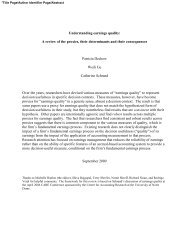Nintendo's “Revolution” - MIT Sloan School of Management
Nintendo's “Revolution” - MIT Sloan School of Management
Nintendo's “Revolution” - MIT Sloan School of Management
Create successful ePaper yourself
Turn your PDF publications into a flip-book with our unique Google optimized e-Paper software.
NINTENDO’S “REVOLUTION”<br />
Sangbeom Kim, Ian Lamont, Hiroshi Ogasawara, Mansoo Park, Hiroaki Takaoka<br />
worldwide before being discontinued. 36 By comparison, the PlayStation 2 sold an estimated 130<br />
million units. 37<br />
Two-Sided Networks<br />
The video game industry was a classic example <strong>of</strong> a business based on network externalities. The<br />
more consoles that were sold, the more independent gaming studios were incented to develop new<br />
titles. This in turn increased console sales. Console makers could also sell their own titles, a tactic that<br />
had worked very well for Nintendo and its Mario Bros. and Pokémon franchises.<br />
As the video game market was growing, hardware was typically sold at a loss right after launch in<br />
order to build a customer base. Once the customer base was established, s<strong>of</strong>tware could be sold at a<br />
higher price and/or volume to make a pr<strong>of</strong>it. Average console costs dropped over time, as<br />
manufacturing scaled up, component costs declined, and the learning curve kicked in. Sony lost an<br />
estimated $100-$160 per PlayStation 2 when it was first launched, but reportedly made up for the loss<br />
with pr<strong>of</strong>its generated by selling game titles and accessories. 38 Micros<strong>of</strong>t also sold consoles at a loss,<br />
in order to establish a presence in the new industry. 39<br />
But the positive feedback loops required to make a successful console were hard to maintain. 40 First, a<br />
constant stream <strong>of</strong> new game titles was required to preserve the value <strong>of</strong> the console hardware, and<br />
convince gamers not to switch. If a platform failed to preserve a steady stream <strong>of</strong> new titles, negative<br />
feedback loops would kick in as gamers and developers abandoned the platform. Second, game<br />
development had become far more complicated in terms <strong>of</strong> game-play scenarios and technology<br />
requirements. In 1996, a typical PlayStation game cost $1 million to develop and sold for $49. By<br />
2003, PlayStation 2 and Xbox games still cost $49, but development costs had risen to between $5<br />
million and $7 million per game. The high costs meant console companies, major game publishers<br />
and independent studios had to rely on a high degree <strong>of</strong> collaboration. These requirements dissuaded<br />
smaller studios from producing lots <strong>of</strong> titles, which created an additional drag on the network<br />
externalities that powered successful platforms. Third, independent game studios did not want the<br />
console market dominated by only Sony and Micros<strong>of</strong>t, as it reduced their bargaining power in pr<strong>of</strong>itsharing<br />
negotiations. This dynamic was actually a boon to Nintendo — many third-party publishers<br />
wanted to help Nintendo with its next console effort, which served as an additional positive network<br />
effect for Nintendo.<br />
36 Nintendo Co., Ltd.: Consolidated Sales Transition by Region. Accessed from http://www.nintendo.co.jp/ir/en/library/historical_data/index.html in June 2011.<br />
37 “Top 25 Video Game Consoles <strong>of</strong> All Time,” IGN.com. Accessed from http://www.ign.com/top-25-consoles/ in December 2010.<br />
38 “The Game <strong>of</strong> War,” Red Herring, October 14, 2001. Accessed from http://www.redherring.com/Home/2699 in June 2011.<br />
39 David Becker and Joe Wilcox, “Will Xbox Drain Micros<strong>of</strong>t?” CNet News, March 6, 2001. Accessed from http://news.cnet.com/Will-Xbox-drain-<br />
Micros<strong>of</strong>t/2100-1040_3-253654.html in June 2011.<br />
40 Tom L<strong>of</strong>tus, “Top Video Games May Soon Cost More,” MSNBC, June 17, 2003. Accessed from<br />
http://www.msnbc.msn.com/id/3078404/ns/technology_and_science-games/ in December 2010.<br />
October 18, 2011 8
















